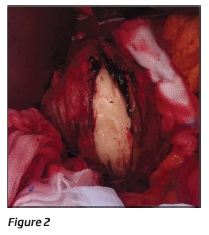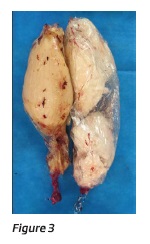Serviços Personalizados
Journal
Artigo
Indicadores
-
 Citado por SciELO
Citado por SciELO -
 Acessos
Acessos
Links relacionados
-
 Similares em
SciELO
Similares em
SciELO
Compartilhar
Angiologia e Cirurgia Vascular
versão impressa ISSN 1646-706X
Angiol Cir Vasc vol.16 no.2 Lisboa jun. 2020
CLINICAL CASE
Exclusion of a large ruptured superficial femoral artery aneurysm with two endoprothesis outside the “Instructions for Use”
Exclusão de um volumoso aneurisma da artéria femoral superficial roto com duas endopróteses fora das “Instructions for Use”
Mafalda Correia1, Pedro Lima1, Luís Antunes1,2, João Alegrio1, Manuel Fonseca1
1 Centro Hospitalar e Universitário de Coimbra
2 Faculdade de Medicina da Universidade de Coimbra
Endereço para correspondência | Dirección para correspondencia | Correspondence
ABSTRACT
Introduction: We present the case of a superficial femoral artery ruptured aneurysm treated with an endoprothesis outside the “Instructions for Use”.
Case report: 83 years old patient with sequential rupture of both superficial femoral arteries aneurysms. In the right limb the patient was submitted to conventional bypass surgery that resulted in an extended recovery period. An endovascular approach was the choice to treat the left ruptured superficial femoral artery aneurysm. The patient was submitted to aneurysm exclusion with two Endurant"II Medtronic® endoprothesis. At two-year follow-up the patient is asymptomatic and the aneurysm remains excluded with no endoleaks.
Conclusions: Despite outside “Instructions for Use”, the use of an endoprothesis to treat SFA ruptured aneurysm presented as limb salvage procedure with excellent technical success and medium-term results.
Keywords: Femoral aneurysm; Rupture; Endoprothesis
RESUMO
Introdução: Apresenta-se um caso de rotura de aneurisma da artéria femoral superficial tratado com uma endoprótese fora das “Instructions for Use”.
Caso clínico: Doente de 83 anos com rotura sequencial de aneurismas de ambas as artérias femorais superficiais. À direita, o paciente foi submetido a cirurgia de bypass que resultou num período de recuperação prolongado, pelo que à esquerda se optou por uma abordagem endovascular. Procedeu-se à exclusão do aneurisma com duas endopróteses Endurant"II Medtronic®. Aos dois anos de follow-up o paciente encontra-se assintomático e sem endoleaks.
Conclusão: Apesar de fora das “Instructions for Use”, o uso de endopróteses na exclusão de um aneurisma da artéria femoral superficial revelou-se como um procedimento limb-salvage com um sucesso técnico e resultados a médio prazo excelentes.
Palavras-chave: Aneurisma femoral; Rotura; Endoprótese
Introduction
Degenerative superficial femoral artery (SFA) aneurysms are rare and the literature regarding their management is scarce. The gold standard treatment of SFA aneurysms is surgical exclusion with an interposition graft or venous bypass(1,2). However, the endovascular treatment of such aneurysms has been proposed as it presents as a less invasive procedure. So far, the use of covered stents is the choice when treating SFA aneurysms with satisfying midterm results(3-5).
The purpose of this paper is to present a case of a patient with a SFA ruptured aneurysm treated with an Endurant"II Medtronic® endoprothesis. The use of these devices is indicated for the endovascular treatment of infrarenal abdominal aortic or aortoiliac aneurysms, which implies an outside the “Instructions For Use” application in this case(6). Until the elaboration of this paper, the authors are unaware of other similar cases described in the literature.
Case report
We present a case of an 83 years old patient, heavy smoker, with chronic etilism and non-medicated hypertension and dyslipidaemia. The patient was admitted to the emergency department with pain in the right thigh with two days evolution. At physical examination, he had fever, a palpable pulsatile mass in the right thigh associated with extensive inflammatory signs and bilateral palpable distal pulses. Patient's blood cultures were negative. An angioCT was performed and revealed multiple lower limbs aneurysms: a right ruptured SFA aneurysm with 10×14cm diameter; a left SFA aneurysm with 4,4×6,3cm diameter; and both hypogastric arteries aneurysms. The patient was submitted to broad surgical drainage of the thigh and to a distal femoro-popliteal “in situ” great saphenous vein bypass. Tissue samples were collected and the patient started empirical antibiotics (Vancomycin and Piperacillin/Tazobactam) while waiting for the result. A Staphylococcus aureus was isolated and the patient remained under Vancomycin for 13 days. The anatomopathological exam revealed a degenerative aneurysm. At the 11th day post-operatively, he presented with surgical wound haemorrhage and was submitted to seroma drainage and haemostasis revision. The patient remained hospitalized for 6 weeks until almost fully wound healing and physical recovery.
Shortly after hospital discharge, the patient was once again admitted to the emergency department with fever and sudden pain in the mid portion of the left thigh. At physical examination, he had a palpable pulsatile mass in the left thigh associated with extensive inflammatory signs and bilateral palpable distal pulses. Patient's blood cultures were negative. An AngioCT was performed and revealed a ruptured left SFA aneurysm with 9,7×12cm diameter.
Considering the contralateral limb surgical background, with delayed wound healing associated with broad surgical drainage, an endovascular approach was a tempting modality. Furthermore, the patient did not have good venous capital left and a prosthetic conduit was not considered given the local limb extensive inflammatory signs. Therefore, the team chose an endovascular treatment. Prior to surgery, informed consent was obtained with the patient. A left femoral common artery surgical approach was performed. The initial angiography revealed a left ruptured SFA true aneurysm (Figura 1).
After systemic heparinization (5000 UI), the aneurysm was crossed with a 0,035 hydrophilic guidewire and exchanged to a Terumo® stiff guidewire. The aneurysm was excluded with two Endurant"II Medtronic® endoprothesis 16×16×124mm and ballooned with an Optimed® Zelos PTA - Balloon Catheter 16mm×4cm.
Final angiography confirmed a proper exclusion of the aneurysm (Figura 2).
The patient immediately started on empirical antibiotics (Vancomycin and Netilmicin) until discharge home, with regression of limb inflammatory signs. Unfortunately, tissue samples were not collected at the time of the surgery.
The patient was discharged home after 8 days, asymptomatic, medicated with single antiplatelet therapy (clopidogrel) and statin. No antibiotics were continued after discharge home in both ruptured aneurysms cases.
At two-year follow-up, the patient is asymptomatic. The control angioCT reveals exclusion of the left SFA aneurysm and no endoleaks (Figura 3).
Discussion
Degenerative SFA aneurysms are uncommon and occur mostly in elderly men. Most are found to be located in the middle third of the artery and present at diagnosis with large diameters. The most common manifestation is a pulsatile tender mass in the thigh, but rupture is also common (42%)(2). Their treatment is advocated for a diameter e 2.5cm and has mostly been through conservative surgery(1). In the last years, endovascular treatment has been reported in the treatment of SFA aneurysms only in a few case reports with a very limited number of cases (less than 5). However, in these reports, authors have reported satisfactory one-year(4,5) and five-year(3) outcomes.
In this case, an endovascular approach was the treatment choice since the patient had no available venous conduit and extensive drainage after bypass surgery to contralateral SFA aneurysm rupture resulted in an extended recovery period and patient's fragility. We could have thought of the possibility of using a prosthetic bypass in this case. However, given the high risk of graft infection and the fact that we did not have promptly available silver-coated conduits, it could not be consider a safe option.
When evaluating the case, the patient had a large diameter SFA aneurysm, with proximal and distal landing zones of 17 and 13,5 mm, respectively, which precluded the use of peripheral approved covered stents. As this was a limb salvage situation, it was decided to exclude the SFA aneurysm with two Endurant"II Medtronic® endoprothesis, which were promptly available at our unit and met the size criteria of this case.
Despite the higher costs associated with this strategy when comparing to conventional surgery, this approach presented as successful procedure, with excellent technical success and medium-term outcome.
Conclusion
Despite outside the “Instructions for Use”, the use of an endoprothesis to treat SFA ruptured aneurysm presented as limb salvage procedure in this case, with excellent technical success and medium-term results.
BIBLIOGRAPHY
1. Pomposelli F, Hamdan A. Lower extremity aneurysms. In: Cronenwett JL, Johnson KW, eds. Rutherford's Vascular Surgery, 7th edn. London: Saunders Elsevier; 2010:2110-2111 [ Links ]
2. Leon LR, Taylor Z, Psalms SB, Mills Sr. Degenerative aneurysms of the superficial femoral artery. Eur J Vasc Endovasc Surg Off J Eur Soc Vasc Surg. 2008;35:332-340 [ Links ]
3. Lawrence P, Harlander-Locke M, Oderich G, Humphries MD, Landry GJ, Ballard JL, et al. The current management of isolated degenerative femoral artery aneurysms is too aggressive for their natural history. J Vasc Surg. 2014;59(2):343-9 [ Links ]
4. Lyazidi Y, Abissegue Y, Chtata H, Taberkant M. Endovascular treatment of 2 true degenerative aneurysms of superficial femoral arteries. Ann Vasc Surg. 2016;30:307.e1-307.e5 [ Links ]
5. Mufty H, Daenens K, Houthoofd S, Fourneau I. Endovascular treatment of isolated degenerative superficial femoral artery aneurysm. Ann Vasc Surg. 2018;49:311.e11-311.e14 [ Links ]
6. Medtronic.https://www.medtronic.com/us-en/healthcare-professionals/products/cardiovascular/aortic-stent-grafts/endurantii/indications-safety-warnings.html [accessed 17 April 2020] [ Links ]
Endereço para correspondência | Dirección para correspondencia | Correspondence
Correio eletrónico: mafaldabmcorreia@gmail.com (M. Correia).
Recebido a 29 de abril de 2020. Aceite a 31 de maio de 2020

















